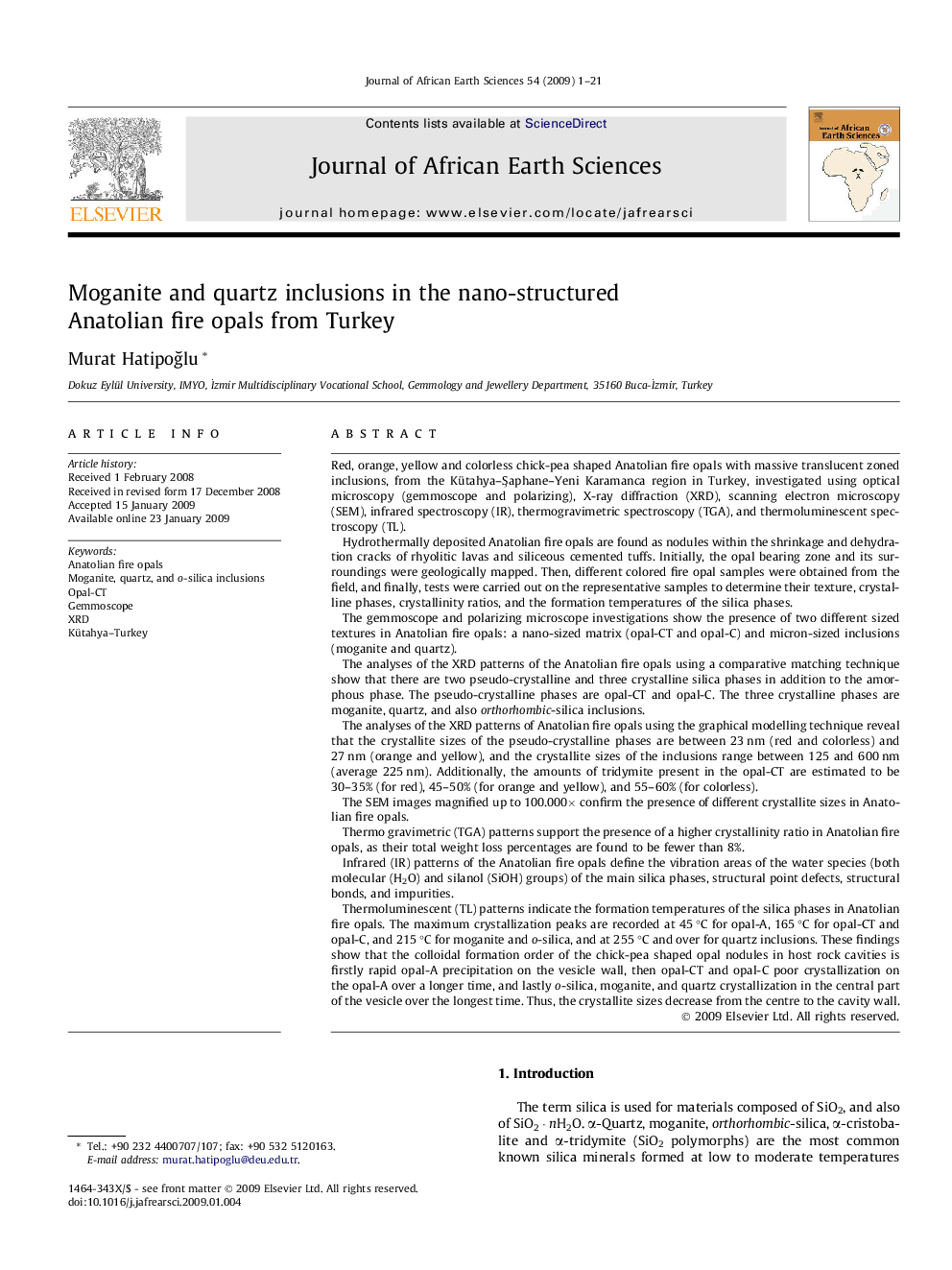| کد مقاله | کد نشریه | سال انتشار | مقاله انگلیسی | نسخه تمام متن |
|---|---|---|---|---|
| 4729515 | 1640251 | 2009 | 21 صفحه PDF | دانلود رایگان |

Red, orange, yellow and colorless chick-pea shaped Anatolian fire opals with massive translucent zoned inclusions, from the Kütahya–Şaphane–Yeni Karamanca region in Turkey, investigated using optical microscopy (gemmoscope and polarizing), X-ray diffraction (XRD), scanning electron microscopy (SEM), infrared spectroscopy (IR), thermogravimetric spectroscopy (TGA), and thermoluminescent spectroscopy (TL).Hydrothermally deposited Anatolian fire opals are found as nodules within the shrinkage and dehydration cracks of rhyolitic lavas and siliceous cemented tuffs. Initially, the opal bearing zone and its surroundings were geologically mapped. Then, different colored fire opal samples were obtained from the field, and finally, tests were carried out on the representative samples to determine their texture, crystalline phases, crystallinity ratios, and the formation temperatures of the silica phases.The gemmoscope and polarizing microscope investigations show the presence of two different sized textures in Anatolian fire opals: a nano-sized matrix (opal-CT and opal-C) and micron-sized inclusions (moganite and quartz).The analyses of the XRD patterns of the Anatolian fire opals using a comparative matching technique show that there are two pseudo-crystalline and three crystalline silica phases in addition to the amorphous phase. The pseudo-crystalline phases are opal-CT and opal-C. The three crystalline phases are moganite, quartz, and also orthorhombic-silica inclusions.The analyses of the XRD patterns of Anatolian fire opals using the graphical modelling technique reveal that the crystallite sizes of the pseudo-crystalline phases are between 23 nm (red and colorless) and 27 nm (orange and yellow), and the crystallite sizes of the inclusions range between 125 and 600 nm (average 225 nm). Additionally, the amounts of tridymite present in the opal-CT are estimated to be 30–35% (for red), 45–50% (for orange and yellow), and 55–60% (for colorless).The SEM images magnified up to 100.000× confirm the presence of different crystallite sizes in Anatolian fire opals.Thermo gravimetric (TGA) patterns support the presence of a higher crystallinity ratio in Anatolian fire opals, as their total weight loss percentages are found to be fewer than 8%.Infrared (IR) patterns of the Anatolian fire opals define the vibration areas of the water species (both molecular (H2O) and silanol (SiOH) groups) of the main silica phases, structural point defects, structural bonds, and impurities.Thermoluminescent (TL) patterns indicate the formation temperatures of the silica phases in Anatolian fire opals. The maximum crystallization peaks are recorded at 45 °C for opal-A, 165 °C for opal-CT and opal-C, and 215 °C for moganite and o-silica, and at 255 °C and over for quartz inclusions. These findings show that the colloidal formation order of the chick-pea shaped opal nodules in host rock cavities is firstly rapid opal-A precipitation on the vesicle wall, then opal-CT and opal-C poor crystallization on the opal-A over a longer time, and lastly o-silica, moganite, and quartz crystallization in the central part of the vesicle over the longest time. Thus, the crystallite sizes decrease from the centre to the cavity wall.
Journal: Journal of African Earth Sciences - Volume 54, Issues 1–2, May 2009, Pages 1–21